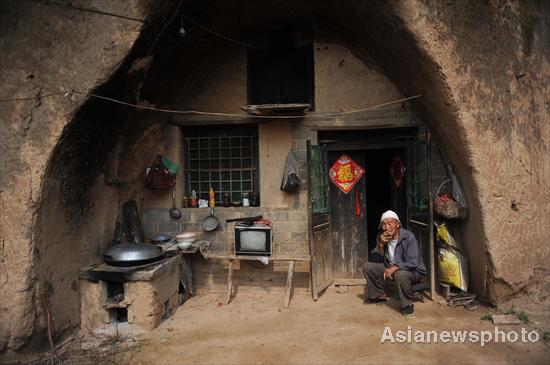30 million Chinese live in caves... -

Reporting from Yanan, China— Like many peasants from the outskirts of Yanan, China, Ren Shouhua was born in a cave and lived there until he got a job in the city and moved into a concrete-block house.
His progression made sense as he strove to improve his life. But there's a twist: The 46-year-old Ren plans to move back to a cave when he retires.
"It's cool in the summer and warm in the winter. It's quiet and safe," said Ren, a ruddy-faced man with salt-and-pepper hair who moved to the Shaanxi provincial capital, Xian, in his 20s. "When I get old, I'd like to go back to my roots."
More than 30 million Chinese people live in caves, many of them in Shaanxi province where the Loess plateau, with its distinctive cliffs of yellow, porous soil, makes digging easy and cave dwelling a reasonable option.
Each of the province's caves, yaodong, in Chinese, typically has a long vaulted room dug into the side of a mountain with a semicircular entrance covered with rice paper or colorful quilts. People hang decorations on the walls, often a portrait of Mao Tse-tung or a photograph of a movie star torn out of a glossy magazine.
The better caves protrude from the mountain and are reinforced with brick masonry. Some are connected laterally so a family can have several chambers. Electricity and even running water can be brought in.
"Most aren't so fancy, but I've seen some really beautiful caves: high ceilings and spacious with a nice yard out front where you can exercise and sit in the sun," said Ren, who works as a driver and is the son of a wheat and millet farmer.
The caves have an important role in modern Chinese history. The Long March, the famous retreat of the Communist Party in the 1930s, ended near Yanan, where Mao took refuge in caves. In "Red Star Over China," writer Edgar Snow described a Red Army university that "was probably the world's only seat of 'higher learning' whose classrooms were bombproof caves, with chairs and desks of stone and brick, and blackboards and walls of limestone and clay."
Read more -
http://www.latimes.com/news/nationworld/world/la-fg-china-caves-20120318,0,2352472.story

Reporting from Yanan, China— Like many peasants from the outskirts of Yanan, China, Ren Shouhua was born in a cave and lived there until he got a job in the city and moved into a concrete-block house.
His progression made sense as he strove to improve his life. But there's a twist: The 46-year-old Ren plans to move back to a cave when he retires.
"It's cool in the summer and warm in the winter. It's quiet and safe," said Ren, a ruddy-faced man with salt-and-pepper hair who moved to the Shaanxi provincial capital, Xian, in his 20s. "When I get old, I'd like to go back to my roots."
More than 30 million Chinese people live in caves, many of them in Shaanxi province where the Loess plateau, with its distinctive cliffs of yellow, porous soil, makes digging easy and cave dwelling a reasonable option.
Each of the province's caves, yaodong, in Chinese, typically has a long vaulted room dug into the side of a mountain with a semicircular entrance covered with rice paper or colorful quilts. People hang decorations on the walls, often a portrait of Mao Tse-tung or a photograph of a movie star torn out of a glossy magazine.
The better caves protrude from the mountain and are reinforced with brick masonry. Some are connected laterally so a family can have several chambers. Electricity and even running water can be brought in.
"Most aren't so fancy, but I've seen some really beautiful caves: high ceilings and spacious with a nice yard out front where you can exercise and sit in the sun," said Ren, who works as a driver and is the son of a wheat and millet farmer.
The caves have an important role in modern Chinese history. The Long March, the famous retreat of the Communist Party in the 1930s, ended near Yanan, where Mao took refuge in caves. In "Red Star Over China," writer Edgar Snow described a Red Army university that "was probably the world's only seat of 'higher learning' whose classrooms were bombproof caves, with chairs and desks of stone and brick, and blackboards and walls of limestone and clay."
Read more -
http://www.latimes.com/news/nationworld/world/la-fg-china-caves-20120318,0,2352472.story
Tidak ada komentar:
Posting Komentar